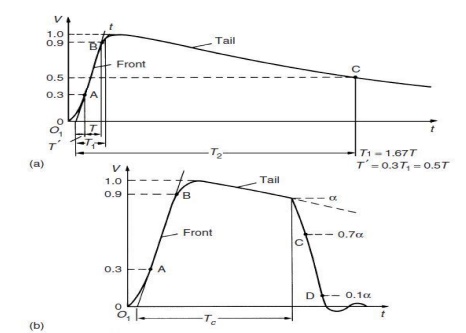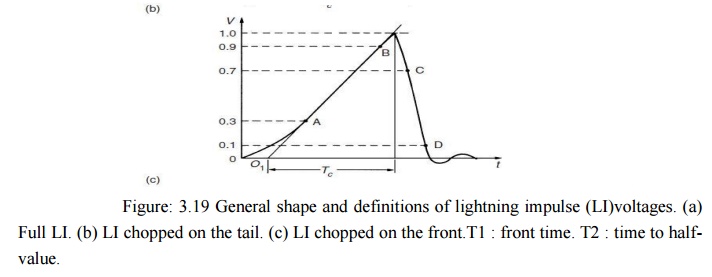As explained in detail in the above Chapter , disturbances of electric power transmission and distribution systems are frequently caused by two kinds of transient voltages whose amplitudes may greatly exceed the peak values of the normal a.c. operating voltage. The first kind are lightning overvoltage, originated by lightning stroke shitting the phase wires of overhead lines or the bus bars of outdoor substations. The amplitudes are very high, usually in the order of 1000 kV or more, as every stroke may inject lightning currents up to about 100 kA and even more into the transmission line;_27_ each stroke is then followed by travelling waves, whose amplitude is often limited by the maximum insulation strength of the overhead line. The rate of voltage rise of such a travelling wave is at its origin directly proportional to the steepness of the lightning current, which may exceed 100 kA/μsec, and the voltage levels may simply be calculated by the current multiplied by the effective surge impedance of the line. Too high voltage levels are immediately chopped by the breakdown of the insulation and therefore travelling waves with steep wave fronts and even steeper wave tails may stress the insulation of power transformers or other h.v. equipment severely. Lightning protection systems, surge arresters and the different kinds of losses will damp and distort the travelling waves, and therefore lightning overvoltage’s with very different wave shapes are present within the transmission system.
The second kind is caused by switching phenomena. Their amplitudes are always related to the operating voltage and the shape is influenced by the impedances of the system as well as by the switching conditions. The rate of voltage rise is usually slower, but it is well known that the wave shape can also be very dangerous to different insulation systems, especially to atmospheric air insulation in transmission systems with voltage levels higher than 245 kV. Both types of over voltages are also effective in the l V. distribution systems, where they are either produced by the usual, sometimes current-limiting, switches or where they have been transmitted from the h.v. distribution systems.
Here they may often cause a breakdown of electronic equipment, as they can reach amplitudes of several kilovolts, and it should be mentioned that the testing of certain l V. apparatus with transient voltages or currents is a need today. Such tests also involve ‘electromagnetic compatibility (EMC) tests’, which will not be discussed here. Although the actual shape of both kinds of overvoltage varies strongly, it became necessary to simulate these transient voltages by relatively simple means for testing purposes. The various national and international standards define the impulse voltages as a unidirectional voltage which rises more or less rapidly to a peak value and then decays relatively slowly to zero.
In the relevant IEC Standard 60, widely accepted today through national committees, a distinction is made between lightning and switching impulses, i.e. according to the origin of the transients. Impulse voltages with front duration’s varying from less than one up to a few tens of microseconds are, in general, considered as lightning impulses. Figure 3.19(a) shows the shape for such a ‘full’ lightning impulse voltage as well as sketches for the same voltage chopped at the tail (Fig. 3.19(b)) or on the front (Fig. 3.19(c)), i.e. interrupted.
Tc: time to chopping. O1 : virtual origin disruptive discharge. Although the definitions are clearly indicated, it should be emphasized that the ‘virtual origin’ O1 is defined where the line AB cuts the time axis. The ‘front time’ T1, again a virtual parameter, is defined as 1.67times the interval T between the instants when the impulse is 30 per cent and90 per cent of the peak value for full or chopped lightning impulses. For front-chopped impulses the ‘time to chopping’ Tc is about equal to T1. The reason for defining the point A at 30 per cent voltage level can be found in most records of measured impulse voltages.


Figure: 3.19 General shape and definitions of lightning impulse (LI)voltages. (a) Full LI. (b) LI chopped on the tail. (c) LI chopped on the front.T1 : front time. T2 : time to half-value.
It is quite difficult to obtain a smooth slope within the first voltage rise, as the measuring systems as well as stray capacitances and inductances may cause oscillations. For most applications, the (virtual) front time T1 is 1.2 μs, and the (virtual) time to half-value T2 is 50 μs.
In general the specifications permit a tolerance of up to 30 per cent for T1 and 20 per cent for T2. Such impulse voltages are referred to as a T1/T2 impulse, and therefore the 1.2/50 impulse is the accepted standard lightning impulse voltage today. Lightning impulses are therefore of very short duration, mainly if they are chopped on front. Due to inherent measurement errors and uncertain tie-in the evaluation the ‘time parameters’ T1, T2 and Tc or especially the time difference between the points C and D (Figs 3.19 (b) and (c)) can hardly be quantified with high accuracy.
Figure 3.20 illustrates the slope of a switching impulse. Whereas the time to half-value T2 is defined similarly as before, the time to peak Tp is the time interval between the actual origin and the instant when the voltage has reached its maximum value. This definition could be criticized, as it is difficult to establish the actual crest value with high accuracy. An additional parameter is therefore the time Td, the time at 90 per cent of crest value. The different definitions in comparison to lightning impulses can be understood if the time scale is emphasized: the standard switching impulse has time parameters (including tolerances) and is therefore described as a 250/2500 impulse.
For fundamental investigations concerning the insulation strength of long air gaps or other apparatus, the time to peak has to be varied between about 100 and 1000 μs, as the breakdown strength of the insulation systems may be sensitive upon the voltage wave shape.

Figure: 3.20 General shape of switching impulse voltages. Tp: time to peak.T2 : time to half-value. Td: time above 90 per cent

